
Verona is a city on the River Adige in Veneto, Italy, with 258,031 inhabitants. It is one of the seven provincial capitals of the region, and is the largest city municipality in the region and in northeastern Italy. The metropolitan area of Verona covers an area of 1,426 km2 (550.58 sq mi) and has a population of 714,310 inhabitants. It is one of the main tourist destinations in Northern Italy because of its artistic heritage and several annual fairs and shows as well as the opera season in the Arena, an ancient Roman amphitheater.
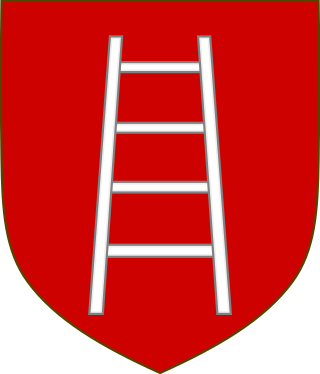
The House of Della Scala, whose members were known as Scaligeri or Scaligers, was the ruling family of Verona and mainland Veneto from 1262 to 1387, for a total of 125 years.

Cangrandedella Scala was an Italian nobleman, belonging to the della Scala family that ruled Verona from 1308 until 1387. He was indeed one of the most important characters at the time of signorie during the period where italy divided in comuni. Now perhaps best known as the leading patron of the poet Dante Alighieri and featuring prominently in Giovanni Boccaccio's almost contemporary Decameron, Cangrande was in his own day chiefly acclaimed as a successful warrior and autocrat. Between becoming sole ruler of Verona in 1311 and his death in 1329 he took control of several neighbouring cities, notably Vicenza, Padua and Treviso, and came to be regarded as the leader of the Ghibelline faction in northern Italy.
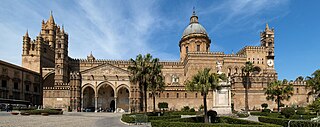
Palermo Cathedral is the cathedral church of the Roman Catholic Archdiocese of Palermo, located in Palermo, Sicily, southern Italy. It is dedicated to the Assumption of the Virgin Mary. As an architectural complex, it is characterized by the presence of different styles, due to a long history of additions, alterations and restorations, the last of which occurred in the 18th century.
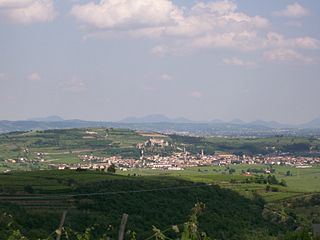
Soave is a small comune of the Veneto region in the Province of Verona, northern Italy, with a population of roughly 6,800 people.
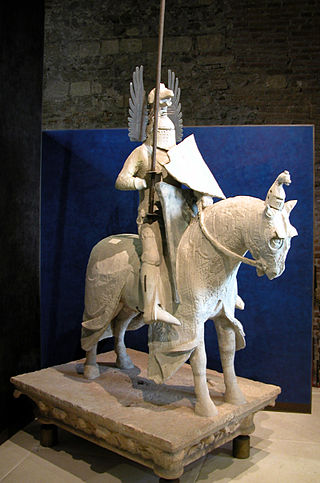
Mastino II della Scala was lord of Verona. He was a member of the famous Scaliger family of Northern Italy.

Ubertino Ida Carrara, called Novello and better known as Ubertinello, was the Lord of Padua from 1338 until his death.

Cansignorio della Scala was Lord of Verona from 1359 until 1375, initially together with his brother Paolo Alboino.

Cangrande II della Scala was Lord of Verona from 1351 until his death.

Alboino I della Scala was the Scaliger Lord of Verona from 1304 until his death.

Paolo Alboino della Scala was a lord of Verona of the Scaliger dynasty.
Rinaldo Cavalchini (1291–1362) lived in Villafranca di Verona near Verona and was better known as Rinaldo from Villafranca.
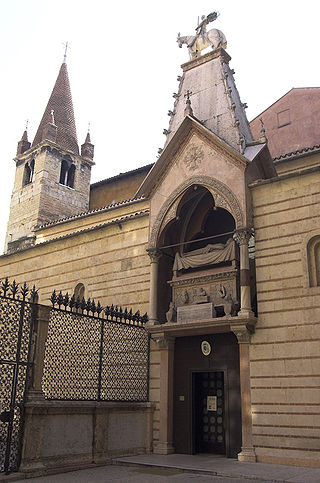
Santa Maria Antica is a Roman Catholic church in Verona, Italy. The current church is Romanesque in style and dates to 1185, rebuilt after the earthquake of 1117 destroyed the original building that dated back to the end of the period of Lombard domination in the 7th century. The only surviving remains of the 7th-century building is a fragment of black and white mosaic floor.

Agnes of Durazzo was the wife of James of Baux, titular Latin Emperor of Constantinople. She was the last woman to claim the title of empress of the Latin Empire.

Marsilio da Carrara was Lord of Padua after his uncle Jacopo I. He was a member of the Carraresi family.
Jacopo or Giacomo I da Carrara, called the Great (Grande), was the founder of the Carraresi dynasty that ruled Padua from 1318 to 1405. He governed with the advice of the leading citizens during a rule characterized by unity within the city. He is usually considered the first lord of Padua (signore), his election marking the transition from commune ad singularem dominum, a characteristic regime known as a signoria to contemporaries.
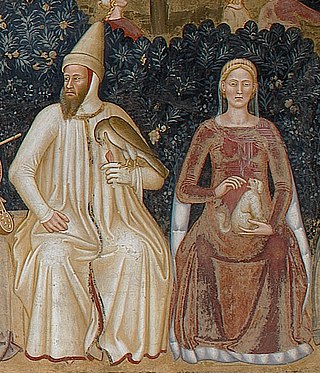
Beatrice Regina della Scala was Lady of Milan by marriage to Bernabò Visconti, Lord of Milan, and politically active as the adviser of her spouse.

The Tomb of Antenor, also called the Sepulchre of Antenore, is a 13th-century monument created to honor an unearthed ancient sarcophagus, claimed to be that of the Trojan warrior and counselor Antenor, the legendary founder of Padua; it is located in Piazza Antenore, in Padua, region of Veneto, Italy.

The Scaliger War was a conflict fought in 1336–1339 between the Scaliger lords of Verona, Mastino II della Scala and Alberto II della Scala, who had built an extensive territorial state in northern Italy, and a coalition of powers threatened by Scaliger expansion. These were chiefly the Republic of Venice, antagonized by the imposition of taxes on overland trade and the Scaligers' threat to end Venetian salt monopoly, and the Republic of Florence, which resented the Scaliger annexation of Lucca, that Florence had claimed for itself. After the first victories of the anti-Scaliger coalition, it was joined by Milan, Mantua, and Ferrara, who all had reasons to fear Scaliger ambitions. The turning point of the war was the end of Scaliger dominion over Padua in 1337, which became a separate, Venetian-influenced lordship under Marsilio da Carrara. The peace treaty, concluded at Venice on 24 January 1339, deprived Mastino II of most of his recent gains, reducing Scaliger domains to Verona and Vicenza. The annexation of Mestre and Treviso to Venice, however, marked the beginnings of the Venetian mainland state.




























